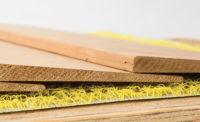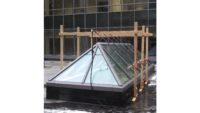
I doubt anyone would disagree that water leaks have been the primary driving force behind defect litigation. Everyone seems to go to extreme lengths to prevent them and protect themselves. All this has also led to an explosion of a cottage industry for investigation and the testing for leaks in walls and windows. When water-leakage or moisture problems are in question, there is an established protocol to follow, which in turn reference certain proper tests for water leakage.
With respect to known leaks, an investigation including specification, plan review, and interviews should be completed prior to window water testing procedures. And while the protocol calls for agreement on procedures, many expert opinions are not always agreed upon before, during and after the water testing is initiated. A majority of the time “maintenance” has been an issue with respect to existing sealant separation from aging of the building or the absence of a sealant. It just makes perfect sense to seal these locations prior to performing ASTM water testing protocol.

LINES OF DEFENSE
Test-induced window leaks are leaks in which there is no history of pre-staining and no sign of leakage existed prior to window testing.
Window flashing and water-resistive barriers, the second line of defense, are installed per the building code standards at the time of construction. A test-induced leak can occur when water that has been injected into the gaps between the window frame and the boarding stucco assembly collects in front of the water-resistive barriers and dams up at the window flashing sill jamb corner intersection. When more than incidental and under high negative pressure, it is possible to travel over the window flashing or down the face of framing members onto the sole plate.

The most common locations for water entry are terminations and/or penetrations in the cement membrane of different materials, such as aluminum and vinyl windows, wood corbels, electrical components, imbedded wood trims, trellis ledgers, fascia board returns, utility panels, etc., that break up the monolithic stucco panel. Without a sealant, these areas can potentially cause test-induced leaks, where no signs of leakage existed prior to water testing.
When evidence of previous water stains are present in the stud bay cavities, a competent forensic expert will record the stain history by outlining the perimeter of these locations with a permanent marker before any water testing begins. Many forensic experts argue that previous stains on framing members may have been “construction stains” while the building was constructed and exposed to the weather elements prior to being clad. This is why it is recommended to document all stain history prior to water testing. The spray rack is a useful tool when used properly by the credible applicator. Water testing, done under design pressures per the “Components and Claddings” section of the code, can verify if the water stains are “construction stains,” active leaks or test induced leaks.

THOSE PESKY CONTROL JOINTS
Control joints in Portland cement stucco are intended to primarily act as artificial planes of weakness to theoretically allow dissipation of stress energy generated by building components at the control joint, rather than find relief in the form of a crack or break in the stucco. Control joints are components of the lath and plaster assembly and not a component of the structure.
Frame buildings must have a water-resistive barrier over all exposed surfaces. This WRB is recommended to be vapor permeable and should be installed in a “shingle-lap fashion.” (Shingle lap means that upper layers always over lap the lower layers.) This installation practice allows incidental moisture to travel downward and ultimately escape at a weep point. Some incidental moisture is absorbed into the cement scratch coat and will escape by solar energy. Solar energy cannot account for significant volumes of water, and if the moisture is allowed to become trapped, problems may arise.
The control joint is a single piece trim accessory intended for limited movement. A control joint has no intended weep provision or flashing flange; the water-resistive barrier must be continuous behind the control joint. The lath may be discontinuous but the WRB must be intact and continuous. This often gives the plasterer a sense of security that water that finds it way through intersection and/or terminations of the control joints will not be a problem. But sometimes it is a problem and will confuse the contractor. The issue is the volume of water entry at these gaps vs. the volume of water exit at the weep point. If the water that enters is at a greater rate than the water can exit, water can dam up and seek other avenues of exit. In extreme cases, the water can even backup and overwhelm a shingle-lap. It is important to “manage” water entry and maximize exit points to keep the assembly in balance.

Envelope consultants often overlook the importance of control joint termination and intersections and focus on the cement membrane. Most are unaware that a properly mixed and applied cement membrane is extremely water-resistant and will not allow liquid water to pass through. Several independent labs and plaster bureaus have verified this fact. Focusing on the proper attachment of control joints and one-piece reveals will pay off with a leak free wall assembly.




Report Abusive Comment